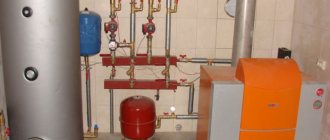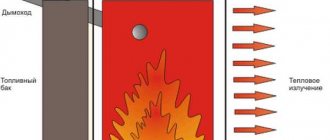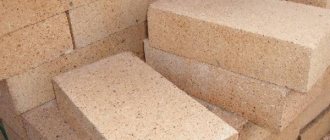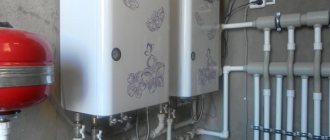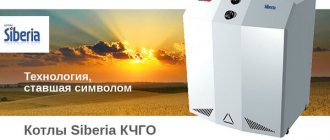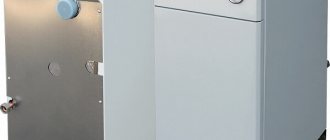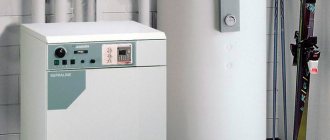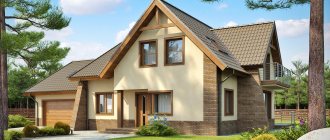Pellet granules - quality and features
In recent years, with rising fuel prices, increasing attention has been paid to the rational use of valuable resources. Pellets - one of its most promising types - are nothing more than granules compressed from waste raw materials.
They are produced using agricultural waste (straw, corn stalks, sunflowers and other crops), as well as wood chips, sawdust and other wood waste. The presence of any chemical components in the composition is completely excluded.
The consumption of pellets per 100 m2 of heated area is determined by calculation or experiment, as in the case of using any other type of fuel.
It is worth noting that pellets, compared to wood and coal, show exceptionally high energy efficiency. The performance characteristics of granules depend on strict adherence to production technology. So, when purchasing them, you should pay attention to the following details:
- The surface of conditioned pellets is shiny and smooth, the presence of cracks and chips is unacceptable.
- Fuel granules must be strong enough and not crumble when vigorously kneaded with your fingers. Otherwise, they will be destroyed by the auger when fed into the firebox into dust.
- The color of the pellets must be uniform. Preference should be given to light-colored granules that contain more wood and less various impurities: bark and small branches. This fuel has better characteristics.
When purchasing this type of solid fuel, you need to take into account the recommendations of the manufacturer of your existing boiler and give preference to hermetically sealed pellets. Packaged pellets are easier to transport and store; they are protected from external influences and dust from settling on them. Granules can be poured directly from the bag into the hopper of a solid fuel boiler.
Features of pellet heating
The fuel in such a boiler is compressed sawdust pellets.
This heating method is environmentally friendly because it uses sawdust left over from woodworking industries as a raw material. This makes full use of plant raw materials and also eliminates the need for waste disposal costs. The sawdust is mixed with a water-based binder and compressed into granules under high pressure and then dried.
Pellets are stored in a bunker next to the heating boiler and are gradually fed into the firebox. For this purpose, a screw mechanism is provided at the bottom of the bunker, reminiscent of a meat grinder screw. It pushes the granules from the bunker into the firebox, where they burn in a smoldering mode, giving off maximum heat.
The boiler automation controls the operation of the motor that rotates the auger. It turns it on if it is necessary to increase the temperature of the coolant, and stops it when the set value is reached.
The supply of pellets in the bunker is enough for a period from several days to a month. This ensures high autonomy of such systems, comparable to the autonomy of liquid fuel boilers.
When purchasing granules, it is necessary to estimate their volume. Traditionally, firewood is measured in volumetric units, cubic meters. Pellets are shipped by weight, in tons and kilograms.
On average, a ton of standard quality pellets in terms of calorific value corresponds to four cubic meters of firewood from wood of the same species.
What do pellets look like?
So far, in terms of purchase price, pellets are somewhat more expensive even than firewood of the highest quality, but with the expansion of the granulated fuel market, prices will inevitably decrease. In terms of ease of use, pellets are many times superior to the usual firewood.
Calculation of the daily requirement of pellets for heating a residential building
It is quite easy to determine the amount of fuel needed for a day, month or heating season. You can calculate the approximate consumption of pellets for heating a house of 200 m2, focusing on the following ratio: when burning 1 kg of high-quality pellets, 5 kW of thermal energy is generated. Accordingly, to obtain 1 kW of power, 0.2 kg of fuel will be required.
An algorithm for more accurately calculating the daily need for pellets for heating residential premises is as follows:
- To create a comfortable microclimate, 0.1 kW of thermal energy per hour per 1 m2 is required with a ceiling height of 2.8 to 3.0 m.
- Accordingly, the consumption of granules will be 0.2 kg/kW • 0.1 kW/(h m2) = 0.02 kg/(h m2).
- We multiply this figure by the area of the house (in our case it is 200 m2) and we get: 0.02 kg/(h m2) • 200 m2 = 4.0 kg/h.
- Daily consumption will be 4.0 kg/h • 24 h = 96.0 kg.
To determine heating costs per day, simply multiply the data obtained by the price of a kilogram of pellets. Please note that the calculations did not take into account the costs of delivering fuel, paying for electricity and carrying out routine maintenance. Meanwhile, to ensure the operation of the heating system - the auger motor, electronic controller, as well as the fan and circulation pump - up to 0.5 kW/h is required. These are significant costs and must also be taken into account.
Fuel granules must be strong enough and not crumble when vigorously kneaded with your fingers.
Fuel consumption per 100 m²
Let's figure out how to calculate the consumption of a pellet boiler in a room with an area of 100 square meters. We can only calculate the approximate volume of how much the boiler consumes, since the consumption is influenced by a large number of parameters: room area, average outside temperature, duration of the heating season, quality of thermal insulation of the house, quality of pellet granules.
When making calculations, we will rely on the fact that when burning 1 kilogram of pellets, 5 kW of heat is generated, the boiler efficiency is 85%, and to heat 10 square meters of a properly built house, 1 kW of energy per hour is required.
To heat a room of 100 square meters. m. per hour, required: 100 sq. m * 1 kW/10 sq. m * 1 kg/5 kW * 0.85 = 1.7 kg. To calculate the consumption per day, multiply the resulting value by 24: 1.7 * 24 = 40.8 kg. The actual monthly consumption will be 30 times higher: 40.8 kg * 30 days = 1224 kg. For such an area, the Cooper OVK 10 solid fuel boiler model is suitable. For 200 square meters, twice as much fuel will be consumed: 1224 kg * 2 = 2448 kg.
You can also see the average consumption of pellets in the technical characteristics of a particular boiler. For example, let’s consider the consumption of Russian-made Zota boilers. The Zota Pellet model with a power of 15 kW consumes 36 kilograms per day, 25 kW – 60 kg/day, 30 kW – 90 kg/day, 100 kW – 250 kg/day. This number shows how much the boiler consumes when operating 10 hours a day and at rated heating output.
Additional factors determining pellet consumption
The above calculation method is good only in theory, but in reality, the volume of actual consumption of fuel pellets can differ significantly from these indicators, up or down. In fact, the consumption of pellets for heating a 100 m2 house depends on many factors, of which two are the most important:
- characteristics and efficiency of the solid fuel boiler used,
- operating mode of heating equipment.
Along with the quality of the pellets, these factors have a significant impact on daily consumption and, in general, on the cost of heating. The owner of a private home can significantly reduce these costs by choosing high-tech and economical equipment and skillfully regulating its operation.
Combined solid fuel pellet boiler
Pellet is pressed wood that has been pre-shredded. It has high efficiency and automatic operation: all you have to do is add fuel. The boiler does the rest.
When choosing such equipment, you will have to do minimal maintenance.
Pellet consumption per day in winter at 25 kW is approximately 4-5 kg/hour - maximum. When the boiler is on modulation, it is 1-2 kg/hour. Such a boiler turns itself on and off: everything happens automatically. Hopper volume: at 240 liters it can load 150-180 kg of pellets - depends on the size of the pellets. Works on different pellet diameters. If you run out, you can also load firewood.
How to check pellets for quality? Take a glass of water and a handful of pellets. Let's mix it all up: if in a few seconds the pellet took on water and sank, then it is a good pellet; if it continues to float for a minute, it is most likely of poor quality.
Efficiency of a solid fuel boiler
Modern equipment for heating systems has a complex design. A good pellet boiler, whose fuel consumption is relatively low, is equipped with a hopper for loading pellets. They are fed into the firebox by a screw as the previous batch burns out; the process of supplying fuel and air is regulated by an electronic controller according to a given algorithm.
Maximum energy efficiency is demonstrated by pyrolysis boilers, the efficiency of which can reach 80-85% due to pressurization and afterburning of furnace gases. Taking this indicator into account, the estimated amount of pellets consumed increases by 15-20% and amounts to 0.023 from 0.024 kg/(m2 h). Thus, for normal heating of a house during the day, you will need from 55.2 to 57.6 kg of fuel for every 100 m2 of heated area.
In this article, we will look at several ways to properly reduce the pellet consumption of your pellet boiler without causing harm to it. Let's start with a short introduction. Here are a few cases when you want to reduce the power of a pellet boiler.
Your boiler is located in a country house or in a house where you do not visit very often. You only want the house to be warm and comfortable when you and your family are in it, but otherwise the boiler should consume as little pellets as possible. This is the first case, which occurs quite often.
Yandex.Direct
| Pellet boiler buyaltep.uaAddress and phone number |
The second situation is also not uncommon - your house is already warm and it seems that your pellet boiler continues to eat pellets. Well, as much as possible! How can I get him to eat pellets less frequently?
What do owners usually do to reduce pellet consumption ? As a rule, they get into the automation of the boiler, into its brains, and simply reduce the supply of pellets - the boiler supplied pellets for 15 seconds, reduce these 15 seconds by 2-3, or even all 10 seconds, and are glad that the boiler began to eat less .
What happens in the boiler when the supply of pellets simply decreases - let's see, see the picture.
The pellet combustion level in the burner simply drops lower, and the pellet feed auger is exposed. The combustion occurs around this same auger and gradually (quickly enough, depending on the power of the boiler, this can happen in one month) the auger burns out, its turns become thin, like a blade, and it fails.
Sometimes the owner, again through the boiler’s automation, reduces the heating temperature of the water in the boiler, i.e. heated the boiler water up to 70 degrees, but let it heat up to...40 degrees (!!!) What happens to the boiler in this case? After 2-3 days (depending on the outside temperature), moisture begins to appear inside the boiler. First, a little, almost imperceptibly, in one corner of the boiler, then in another, in a third, and now the inside of the boiler is all wet. Moreover, black, acrid smoke begins to pour out of the chimney.
Cleaning the boiler generally turns into hell, because... When you open the door of the boiler, the stench is such that you think you are not in your own home, but at a barbecue in the forest. And, of course, everyone is to blame for this - the seller of the boiler, its manufacturer, the pellet manufacturer. Although in reality they have nothing to do with it. The owner himself is to blame. He brought his boiler out of normal operation.
How can you make sure that you do not witness such apocalyptic situations and are not disappointed with the purchase of the boiler? You just need to know a few simple things.
Yandex.Direct
| Are you looking for boilers for heating your home? October sale Discounts up to 1000 UAH Delivery 30 month guarantee.kotel.vitiaz.bizAddress and phone number |
FIRST: The water temperature inside the pellet boiler should always be above 60 degrees. This will prevent the appearance of a dew point inside your boiler, the same one that caused moisture to form inside the boiler in the story I described above. All fuel contains moisture. It is also present in pellets. If you lower the heating temperature of the water in the boiler below 60 degrees, the moisture in the fuel will begin to condense on the heating surfaces of the boiler. Combustion products begin to stick to the moisture, the moisture enters into a chemical reaction with the flue gases, forming a tarry substance that smells simply terrible and solidifies into glass at room temperature.
SECOND: The level of pellet combustion in the burner must always be higher than the auger (see picture). This will guarantee that the auger will not burn out ahead of time and will serve you for a long, long time.
And now the answer to the question of the article - how to properly reduce the pellet consumption of your pellet boiler without causing harm to it:
If the house becomes hot, turn off the heating radiators using the taps located on each radiator. If there are no taps on the radiator, cover the radiators with blankets. In a word, do not allow them (heating radiators in the house) to release their heat into the house. Let it (heat) pass by them (radiators) and enter the boiler. In this case, your boiler will simply turn on much less often, which means that fewer pellets will be burned, significantly less.
There is another way to reduce the heat supply to the house - turn up the supply or return valve of your pellet boiler by 50-70%. The effect will be exactly the same as I described two sentences above.
This way you will keep the boiler in working condition and reduce the consumption of pellets .
The influence of the boiler operating mode on pellet fuel consumption
The above theoretical calculations were performed for heating equipment operating at maximum power. This mode is only used at extremely low temperatures, which in reality are extremely rare. Accordingly, the consumption of pellets for heating should be calculated based on lower indicators: 0.05 kW of thermal energy to heat 1 m2 of the total area of the house per hour.
The daily consumption of granulated solid fuel, calculated at the rate of 0.1 kW/(m2 h), must be proportionally halved. Accordingly, the calculated pellet consumption rates will be in the range from 27.6 to 28.8 kg/100 m2. It will be possible to further reduce heating costs if you reduce heat loss by insulating the house and installing double-glazed windows.
A good pellet boiler for heating a private home, whose fuel consumption is relatively low, is equipped with a hopper for loading pellets.
How to calculate pellet consumption?
Considering the fact that fuel is supplied in bulk or packaged in bags, it is, in principle, not difficult to calculate the consumption of pellets per 1 kW or per 1 m2. There is no need to convert weight units into volume, since delivery always occurs in kilograms, and the heat of combustion of fuel is also measured in kW per 1 kg of weight.
Good quality granules have excellent calorific value; burning 1 kg of such fuel produces almost 5 kW of thermal energy. Accordingly, to get 1 kW of heat for heating a house, you need to burn about 200 grams of pellets. The average consumption of granules per unit area can be easily determined based on the fact that heating each 1 m2 of area requires 100 W of energy. One condition is important: the ceiling height should be within 2.8-3 m. 100 W of heat will be obtained from 20 grams of granules, it would seem simple arithmetic.
But it was not there. The figures presented above are correct if the pellet boiler has absolute efficiency - 100% efficiency, but this does not happen in real life. In fact, the efficiency of such heat generators, although higher than that of solid fuel boilers, is still only 85%. This means that after burning 1 kg of pellets in the furnace of the unit, not 5 kW of energy will be obtained, but 5 x 0.85 = 4.25 kW. Conversely, to release 1 kW of heat in pellet boilers, 1 / 4.25 = 0.235 kg or 235 grams of fuel is consumed. This is the first point.
The second nuance is that 100 W of heat per 1 m2 of room is required when the ambient temperature is the lowest, which lasts for 5 days. On average, during the heating season, thermal energy consumption is half as much. This means that the specific heat transfer per unit area is only 50 W. Determining the consumption of pellets in a pellet boiler for 1 hour relative to 1 m2 will be incorrect; the figure will be small and inconvenient. It would be more correct to calculate the weight of pellets burned per day.
Since Watt is a unit of power per 1 hour, then per day for each square of the room you will need 50 W x 24 hours = 1200 W or 1.2 kW . For this purpose, you will need to burn the following mass of pellets per day:
1.2 kW / 4.25 kW/kg = 0.28 kg or 280 grams.
Knowing the specific fuel consumption, we can finally obtain values useful for financial calculations, for example, the average seasonal weight of pellets used per day and per month in a house with an area of 100 m2:
- per day – 0.28 x 100 = 28 kg;
- per month – 28 x 30 = 840 kg.
It turns out that 8.4 kg of fuel is needed per month to heat 1 m2 of a building. At the same time, according to user reviews on various forums, heating a well-insulated house of 100 m2, located in the middle zone, takes about 550 kg of pellets, which in terms of square footage is 5.5 kg/m2. This means that the consumption of pellets in the boiler in the amount of 840 kg per month for a building of 100 m2 is very large and suitable for calculations of poorly insulated houses.
Let us summarize some results in the form of calculation results for dwellings of various sizes. The following are the monthly costs of pellets for heating a private home:
- 100 m2 – 840 kg with poor insulation, 550 kg for good thermal insulation;
- 150 m2 – 1260 kg and 825 kg, respectively;
- 200 m2 - 1680 kg and 1100 kg under the same conditions.
For reference . In many boiler installations, the controller has a function that allows you to see on the display the consumption of pellets in kilograms over a certain period.
Advantages and disadvantages of fuel pellets
The use of modern equipment for heating residential premises not only provides significant savings, but is also very convenient. A pellet boiler whose daily fuel consumption does not exceed the calculated values must be loaded exclusively with high-quality fuel.
Granules made from softwood and hardwood with a slight admixture of bark, as well as from rapeseed straw, have many advantages over other types of solid fuel, and here are the main ones:
- Easy to ship, save and use. High-quality pellets are packed into sealed durable bags, which allows for faster loading and unloading operations and provides convenience for storage and use.
- Competitive and stable price. In recent years, due to the obvious increase in production volumes, there has been a tendency towards a slight decrease.
- The use of automated feeding and the low consumption of a pellet boiler relieve the owner of the annoying need to regularly add fuel - it is enough to fill the bunker once a day.
For all their advantages, pellets also have a number of disadvantages. First of all, these are large initial costs for equipment: prices for pyrolysis boilers are significantly higher than for gas or electric ones.
In addition, the granules must be stored exclusively in a dry, ventilated area, avoiding contact with moisture. Violation of storage conditions leads to a decrease in the calorific value of fuel.
Criteria for choosing the power of a pellet boiler
How to calculate the power of a pellet boiler?
The criteria are as follows: Collapse Contents:
- Heated area
- Wall material
- Wall thickness
- Room temperature
- Pellet quality
- Other factors
- Formula for calculation
- Calculation of power and approximate consumption of pellets for a home
- 35 sq.m
- 64 sq.m
- 100 sq.m
- 150 sq.m
- 200 sq.m
- 250 sq.m
- conclusions
- Room area. Power is taken at the rate of 1 kW per 10 m2. Household models start from 15 kW. We recommend taking 20% as reserve.
- Efficiency of a pellet boiler. It ranges from 85% to 95%. With the same power indicators, we choose the one whose efficiency is higher.
- The use of alternative fuels will reduce power by 20-40%.
- Using raw pellets will result in a loss of another 25-35% of power.
Heated area
Room area is the main criterion for choosing a boiler. Temperatures in winter can drop well below average. The costs of additional insulation can significantly exceed the cost of purchasing a more powerful modification of the boiler and cause a lot of household troubles.
Wall material
Different materials have different thermal conductivities. The lower the thermal conductivity of the wall, the less heat loss. For the calculation, you can take the thermal conductivity coefficients from SNiP 23-02-2003 and from SP 50.13330.2012.
The material changes thermal conductivity under different operating conditions, in particular with increasing humidity. The thermal conductivity coefficient under different operating conditions can be found on the manufacturer’s website.
Let us give the average thermal conductivity of some materials under normal conditions:
- brick - 0.7 W/(m*°C);
- reinforced concrete - 1.92 W/(m*°C);
- pine - 0.14 W/(m*°C);
- foam concrete - 0.28 W/(m*°C);
- oak - 0.18 1.92 W/(m*°C).
Wall thickness
The thickness of the wall is determined by thermal engineering calculations. The calculation process is simplified by special complexes where the user needs to enter initial data. The machine will carry out the calculations and produce the finished result.
Window and door openings increase thermal conductivity. The larger the area of the openings, the higher the heat loss. The use of modern metal-plastic double-glazed windows can partially solve this problem.
Room temperature
Walls are only part of the source of increased thermal conductivity. Heat exchange passes through the floors and roof. The presence of a basement will further increase heat loss. To maximize resource savings, you need to carefully insulate all structures.
The temperature in the room is considered comfortable: +22 - +240 C. Optimal humidity is 60-80%. Supply and exhaust ventilation must be provided to create complete air exchange.
Pellet quality
The quality of fuel plays a decisive role in heating a home. If you use raw pellets, the boiler power will drop by 25-35%. Part of the energy obtained during combustion will be used to dry low-quality pellets. It is extremely important to ensure optimal conditions for fuel storage. First of all, it should be a dry and warm place.
Raw materials also play an important role. In the West, this type of fuel has been used for more than a century. The production system and criteria have been developed and standardized at the state level. Our country cannot boast of this.
No uniform quality standards have been developed for this type of product. Each manufacturing enterprise is forced to rely only on its own, unfortunately, not rich experience. There is a high risk of buying low-quality products.
Pellet boilers can operate on almost any type of solid waste. There are models that support different types of fuel. But the efficiency of such boilers is usually much lower.
Other factors
Other factors influencing the choice of a pellet boiler include:
- geographical area;
- average annual precipitation;
- average wind strength and direction;
- conditions and frequency of operation of residential premises;
- type of fuel used;
- quality of materials from which the boiler is made;
- ceiling height;
- price.
It is simply impossible to take into account all factors in the calculation. Their performance can change quite significantly over time. For example, winter may be colder than usual. Or the wind speed, instead of the usual 4-6 points, will be 8 - 9.
Cost of heating a house with pellates. Comparative analysis with other types of solid fuel
Pellets are an excellent alternative to softwood or hardwood firewood and coal. The main disadvantage of traditional types of solid fuel is the inconvenience of use. Firewood must first be sawed, chopped and dried, but coal leaves a fair amount of dirt behind.
Let's try to calculate, using a live example, how much it will cost to purchase firewood for heating a residential building of 100-150 m2. On average, the price for 1 m3 of firewood is 1,500 rubles; for the winter, such an area will require from 30 to 40 m3 for a total amount of 45 to 60 thousand rubles. If the wood is wet, its heat transfer will be quite low, and more firewood will be required.
At the same time, the average consumption of pellets for heating a house of 150 m2 is about 1270 kg per month or 7.6 tons for six months. It is impossible to say exactly how much 1 ton of pellets will cost, so we will take the average value. With the price of wood pellets from 3,500 to 5,000 rubles, the cost of purchasing fuel will range from 26,600 to 38,050 rubles. As you can see, the cost of heating with pellets is much lower than the cost of heating with alternative solid fuel.
Consumption of pellets for heating a house 150m2
In a not very severe winter, 50W is needed to heat 1m2 per hour. For the whole day this is 1200 W.
The amount of pellets burned to produce heat of 1 m2 per day will be 1200 W/4.25 kW/kg = 280 g.
- per day: 0.28kg*150m2=42kg.
- per month: 42kg*30days=1260kg.
But these figures also turn out to be overestimated if the house is well insulated. Many homeowners with a well-insulated home spend much less kg. On average, the amount needed is reduced by 35%. Then the cost of heating a 150 sq. m house with pellets is also reduced by this amount. Similarly, the amount of raw materials required per month is reduced to 825 kg.
Correct boiler settings
When buying a pellet boiler, first of all you need to pay attention to the availability of service centers and official representative offices in the region where the boiler is installed. The pellet boiler is fully automated and requires proper configuration and maintenance. Correctly setting up the boiler will increase its service life, reduce fuel consumption and simplify cleaning the boiler. Start-up and commissioning of this kind of automated equipment must be carried out by a specialist authorized by the manufacturer. In fact, there are no restrictions on starting the boiler and putting it into operation; this procedure can be performed by the installer who installed the heating system, and of course by the user himself. But in this case, all responsibility and further maintenance falls on the person who carried out the launch.
What is important to know to set up a pellet boiler yourself? First of all, you need to understand that an automatic pellet boiler has several operating modes. The most basic and those that require more attention are three: Ignition, Work, Pause. Boiler manufacturers use different types of automation in which all kinds of additional modes can be used, such as: Combustion Stabilization Mode, Modulation Mode, Supervision Mode, etc. When we already have an idea of the modes, it is important to understand how the boiler should behave in each mode.
Ignition mode - when a certain portion of pellets is supplied to the burner using an igniter, or in manual mode it is ignited and complete combustion is stabilized. The boiler usually spends about fifteen minutes in this mode, during which time it also supplies pellets in certain portions, while the boiler automation monitors the temperature of the flue gases. In this mode, it is very important to set up a sufficient amount of pellet supply and air injection so that the temperature of the flue gases rises rapidly. After the flue gases reach 60 degrees, the chimney is considered warmed up, and the automation switches the boiler to Operating mode.
We recommend: Insulating a well for the winter with your own hands: methods, depth of soil freezing, video and photos
The operating mode is very similar to the ignition mode. The boiler spends most of its time in this mode. It is at this time that it heats the boiler heat exchanger and brings the temperature in the heating system to the set temperature. During our work, we no longer need to quickly warm up the chimney. Our task is to achieve correct and complete combustion of pellets, a stable and clean flame. Two parameters are subject to adjustment: air blowing power and the number of supplied pellets. The air power is usually regulated in a ratio from 30 to 100 percent, the number of pellets supplied to the burner is regulated in a cyclic ratio, and after a certain period of time a certain portion of pellets is supplied. It is important to understand that the portion of burned pellets corresponds to the declared power. For example, a fifty kilowatt boiler will not be able to provide heat to the room if the supplied pellets are too small, even if the flame is stable. The average heat transfer of pellets from one kilogram when burned can produce up to five kilowatts of thermal energy per hour. The quality of the fuel can greatly affect the consumption of pellets, and in some boilers, the operation of the burner.
Manufacturers of pellet boilers provide standard operating settings. Each power has its own number of pellets per hour and its own air blowing power. Our task as a user or boiler setup specialist is to adjust these parameters so that pellet combustion is complete and consumption is minimal without loss of boiler performance.
This begs the question, where to start setting up a pellet boiler?
We recommend that you first start by adjusting the air and blowing power of the fan. The blowing power may vary for each boiler; it is usually influenced by a number of factors, such as chimney draft, pellet quality and even burner type. The amount of air pumped into the burner should be the minimum necessary for complete combustion of the fuel. This can be determined by the color of the flame.
The correct flame has a yellowish tint, the flames rise upward, the combustion is even, high and stably kept at the same height. It is in such a flame that maximum efficiency is achieved.
Is the flame reddish with noticeable smoke? There is not enough oxygen for combustion; this can be affected by both an incorrectly installed chimney and too little air blowing power. Try adding blowing power and observe the result.
If we observe an aggressive flame, and pellet coals jump up and fall into the ash pan as unburnt pellets, there is too much air blowing, we recommend reducing the air to the minimum required for combustion.
After the flame has been normalized and it meets all the parameters of proper combustion, it has a yellowish tint. Let's move on to adjusting the auger feed. As mentioned above, the auger operates cyclically, feeding certain portions into the burner. Before setting up the auger feed, you need to understand what type of burner your boiler has. A torch burner requires the minimum required number of pellets when burning, so that the pellets do not clog the air supply holes. In such burners, pellets are usually fed in small portions. If we are dealing with a retort burner in the form of a bowl with bottom fuel supply. Here the fuel supply occurs somewhat differently; the pellets supplied from below constantly raise the combustion. Our main task is to adjust the optimal supply of pellets to the burner so that the fuel during combustion is always at the same level. Combustion should occur in the upper part of the burner, and the pellets should not spill over the edge of the burner or sink below the level.
After we managed to select the ratio of pellet supply and air inflation, we should observe the temperature of the water in the system, whether it tends to the set one, and at what speed. Is the boiler gaining temperature very slowly or is the temperature stuck in one place? This means that the boiler is not operating at rated power; it is necessary to add fuel supply and adjust combustion.
We recommend: Replacing a gas boiler in a private house: how to properly replace an old unit, how to connect a new one to the heating system
The final mode is Pause or Stop mode. The pellet boiler goes into this mode when the set task, namely the set temperature, has been achieved. In this mode, the boiler completely turns off the operation of the auger and fan, and waits for the water temperature in the system to drop by several degrees, after which it starts working again, before checking the combustion.
The question is very often asked: Is it necessary to reconfigure the boiler when changing fuel? If these are fundamentally different fuels then - Yes.
For example: We made a tincture using wood pellets, and a little later we decided to switch to husk pellets. Husk pellets burn a little faster than wood pellets and the feed ratio of the auger to the fan needs to be changed.
If the fuel is simply from different batches or from a different manufacturer, then only a slight adjustment of one of the parameters will be necessary. Pellets may differ in density, humidity, calorie content, as well as ash content and the likelihood of caking and cake formation.
Pellet boilers have gained popularity in the line of solid fuel boilers due to their autonomous operation and convenient operation. Such boilers can work from 2 to 10 days on one loading of the bunker and with cleaning the boiler every 4-5 days, while a long-burning boiler with automation will not last even 24 hours and needs regular cleaning before each loading of firewood. However, pellet boilers require proper tuning and it is better to entrust commissioning work to a specialized organization. A properly configured boiler will easily develop the specified power, and the savings on pellets will pleasantly surprise you.
